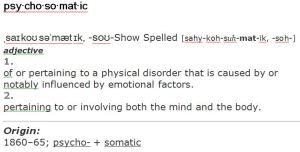A Bridge to the Unconscious Mind
Why is it always about breathing? Whether you’re in a karate dojo, a yoga class or a hypnotherapist’s office, they’re always prattling on and on about breathing. “Take three cleansing breaths.” “Imagine your breath going here, going there.” Why all this focus on a bodily function that’s as basic as your heartbeat? It’s because breathing is different.
Your conscious thinking mind, for the most part, has no direct effect on most of the functions of your autonomic nervous system. You don’t “think” about secreting cortisol from your adrenal gland, you don’t “think” about your heartbeat and most of the time you don’t think about your breathing, but you can. Right now you can choose to breathe faster, slower, hold your breath. Try holding your heartbeat. (Go on, I dare you.)
The unconscious mind. (We really need a better name for it, as it is not “un” conscious at all, but let’s save that for another posting.) Okay, moving on, the unconscious mind does have an effect. In fact, it could almost be said that the autonomic nervous system IS the unconscious mind, with what we typically call the unconscious “mind” being simply the portion of the system that regulates behavior like the hypothalamus regulates body temperature. (Among other things)
It make very logical sense that when we want to pass information from the thinking mind to the unconscious “operating system” and vice versa, we use the few functions that are under the control of both system (breathing, eye blinking) as a bridge.
The language of the unconscious “mind” is a visual metaphor so you will find everyone from the Hypnotherapist in his office, the Yogi on the mountaintop, to the Massage therapist giving chair massages in the mall, telling you to “focus on your breathing,” visualize it as this color or that. See it going here or there. Breathing is a bridge between the conscious and the unconscious. This bridge runs both ways. You can “inhale” a healing light as well as “exhale” stress or pain.
We live in a time when science and logic seem to be at war with ancient wisdom that has stood the test of time. In this day and age so many alternative practices are looked down upon as metaphysical and so much “woo woo voodoo,” but when we truly understand the logic behind these practices, they can make sense and are as much physics as metaphysics.
Wes Graham C.C.Ht.



